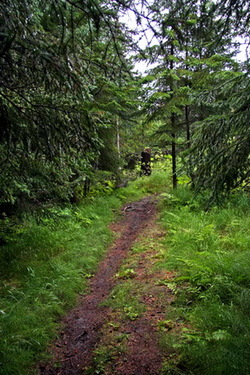The Homer Soil and Water Conservation District recognizes the many values of our Kenai Peninsula forests. Local forests give us building materials and firewood, protect soils from erosion, provide wildlife habitats, offer places where we can recreate and “get away,” contribute “large woody debris” to streams—which improves instream habitats for salmon and other aquatic species, and give us products like berries, mushrooms, and mosses. Forests can even be managed to “sequester” carbon, which helps slow climate change. The Homer Soil and Water Conservation District conducts programs to help landowners and managers learn about, enjoy, and sustain local forests.

The Homer Demonstration Forest (HDF) is a 360-acre forest that the District helped establish in 1986 just west of the City of Homer, on land owned by the state. The District chairs the HDF Steering Committee, which manages the forest under an agreement with the Alaska Department of Natural Resources, Division of Forestry. The Steering Committee involves numerous agencies, schools, and local recreational groups.
Overall goals and objectives of the HDF are to develop an outdoor educational setting focused on forests, forestry, forest recreation, natural resource stewardship, and watershed protection. The District has conducted a number of projects in the forest related to tree planting, education, and improvement of summer trails.
Click here for more information on the Homer Demonstration Forest
Forest Stewardship and Forest Management Plans
Individuals with 7 or more acres of land that are forested or “capable of growing trees” are eligible to receive a “Forest Stewardship Plan” (FSP) from the Alaska Division of Forestry or a “Forest Management Plan” (FMP) from the Natural Resources Conservation Service. These forest plans are provided at no cost to landowners, because communities benefit if local forestlands are managed in ways that maintain or increase their long-term productivity along with local environmental quality.

Although addressing somewhat different criteria, both of these kinds of forest plan are developed with landowner involvement and are based on landowner goals. After landowner goals have been identified, trained personnel conduct site visits to measure tree size and density, assess forest conditions, and identify insect or disease threats. Observations are also made about wildlife use, as well as what landowners can do to reduce wildfire risks.
Landowner goals and collected information are summarized in a written plan. Plans are designed to help landowners understand the current condition of their forestlands and what actions they can take to achieve identified goals. Recommendations are provided for tree planting and tree care, as well as for improving wildlife habitats and/or recreation.
Forest plans do not obligate landowners to particular actions, but landowners may formally agree to manage their forestlands in ways that are consistent with the plan. As a result, certain actions may be eligible for cost-share reimbursement. Examples include thinning forest stands to improve tree health and growth rates and preparing soils for tree seeding.
